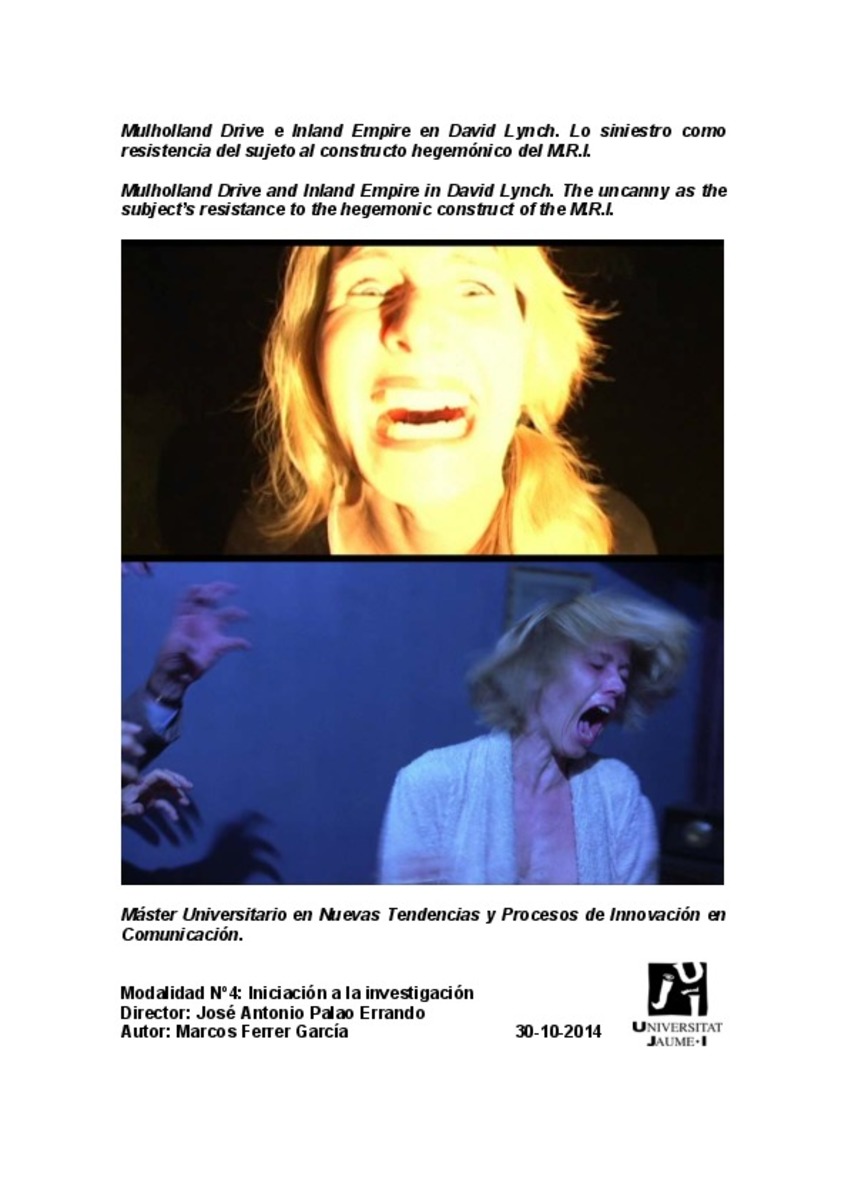Mostrar el registro sencillo del ítem
Mulholland Drive e Inland Empire en David Lynch. Lo siniestro como resistencia del sujeto al constructo hegemónico del M.R.I.
| dc.contributor | Palao Errando, José Antonio | |
| dc.contributor | Universitat Jaume I. Departament de Ciències de la Comunicació | |
| dc.contributor.author | Ferrer García, Marcos | |
| dc.date.accessioned | 2015-03-24T12:30:04Z | |
| dc.date.available | 2015-03-24T12:30:04Z | |
| dc.date.issued | 2014-11-11 | |
| dc.identifier.uri | http://hdl.handle.net/10234/116322 | |
| dc.description | Treball Final del Màster Universitari en Noves Tendències i Processos d'Innovació en Comunicació (Pla 2013) . Codi: SAZ052. Curs acadèmic 2013-2014 | ca_CA |
| dc.description.abstract | El presente trabajo de investigación estudia la hipótesis de que lo siniestro pueda surgir desde la ruptura narrativa en la representación hegemónica cinematográfica. Para ello parte del análisis fílmico de las dos últimas películas de David Lynch: Mulholland Drive e Inland Empire. El objetivo es relacionarlas con el concepto de lo siniestro desarrollado por el psicoanálisis, así como sus interrelaciones con una parte de la filosofía existencialista, y los estudios de la imagen en diferentes ámbitos que hacen especial hincapié en el encuentro de esta con el sujeto. Todos ellos tienen en común encargarse de esa parte del ser que no puede articularse en lo concreto de la palabra ni se aviene a ser integrado en un orden simbólico, lo real. La comparación con otros conceptos próximos a la experimentación de lo siniestro como el terror, lo fantástico o incluso la melancolía nos muestra sus lugares comunes, pero también destaca su particularidad diferenciadora: la caída simbólica de la realidad sobre la que se sustenta el sujeto, estableciendo un corte en el flujo de su continuidad. Basándose en todo lo anterior la hipótesis pone especial énfasis en el papel nuclear del sujeto a la hora de suturar la representación fílmica y hacerse cargo de la interpretación, teniendo presente la implantación de las características y códigos del M.R.I. como adaptación de la narración literaria al “lenguaje” cinematográfico, todo ello sin olvidar su constante maleabilidad a lo largo de los tiempos. En este tipo de cine, la percepción o reconstrucción de la linealidad deviene fundamental. Frente a ella David Lynch propone una reivindicación del sujeto/espectador activo y, en consecuencia, hace surgir lo siniestro desde la materialidad de ambas películas que evidencian y quiebran la representación hegemónica, mostrando las costuras narrativas que no pueden contener lo real y que en su cine adoptan la manifestación de lo siniestro. | ca_CA |
| dc.description.abstract | This research paper studies the hypothesis stating that the uncanny might arise from a narrative break in the hegemonic cinematographic representation. It builds on the filmic analysis of David Lynch’s two latest films: Mulholland Drive and Inland Empire. The aim is to link them with the concept of the uncanny as developed by psychoanalysis, as well as establish their interrelations with a part of existentialist philosophy and the study of image in various disciplines which delves on the interface between image and subject. Their common feature is that they deal with the part of the being which cannot be articulated by the precise nature of words or integrated into a symbolic order – the real. The comparison to other concepts analogous to the experience of the uncanny, such as terror, fantasy or even melancholy, reveals some parallelisms, but it also emphasizes its divergent specificity: the symbolic fall of the reality on which the subject relies, which introduces a break into its continuum. Based on all of the above, the hypothesis particularly highlights the nuclear role of the subject when it comes to suturing the filmic representation and assuming the responsibility of interpreting its sense, taking into account the pervasive characteristics and codes of the M.R.I. as an adaptation of literary narrative to the language of cinematography, and bearing in mind their constant malleability through time. In this kind of cinema, the perception or reconstruction of linearity becomes essential. Opposite this, David Lynch advocates for a vindication of the active role of the subject/spectator and, thus, makes the uncanny arise from both films’ materiality, which reveals and ruptures the hegemonic representation, exposing the narrative seams which cannot contain the real, causing it to become, in his films, a manifestation of the uncanny. | ca_CA |
| dc.format.extent | 153 p. | ca_CA |
| dc.format.mimetype | application/pdf | ca_CA |
| dc.language.iso | spa | ca_CA |
| dc.publisher | Universitat Jaume I | ca_CA |
| dc.rights | Attribution-ShareAlike 4.0 Spain | * |
| dc.rights.uri | http://creativecommons.org/licenses/by-sa/4.0/ | * |
| dc.subject | Màster Universitari en Noves Tendències i Processos d'Innovació en Comunicació | ca_CA |
| dc.subject | Máster Universitario en Nuevas Tendencias y Procesos de Innovación en Comunicación | ca_CA |
| dc.subject | Master’s Degree in New Trends and Innovation Processes in Communication | ca_CA |
| dc.subject | Siniestro | ca_CA |
| dc.subject | Lynch | ca_CA |
| dc.subject | Sujeto | ca_CA |
| dc.subject | Análisis cinematográfico | ca_CA |
| dc.subject | Representación | ca_CA |
| dc.subject | Uncanny | ca_CA |
| dc.subject | Subject | ca_CA |
| dc.subject | Analysis | ca_CA |
| dc.subject | Cinematography | ca_CA |
| dc.subject | Representation | ca_CA |
| dc.title | Mulholland Drive e Inland Empire en David Lynch. Lo siniestro como resistencia del sujeto al constructo hegemónico del M.R.I. | ca_CA |
| dc.title.alternative | Mulholland Drive and Inland Empire in David Lynch. The uncanny as the subject’s resistance to the hegemonic construct of the M.R.I. | ca_CA |
| dc.type | info:eu-repo/semantics/masterThesis | ca_CA |
| dc.educationLevel | Estudios de Postgrado | ca_CA |
| dc.rights.accessRights | info:eu-repo/semantics/openAccess | ca_CA |
Ficheros en el ítem
Este ítem aparece en la(s) siguiente(s) colección(ones)
-
TFM: Màster Universitari en Noves Tendències i Processos d'Innovació en Comunicació [177]
SAZ052, SAZ053, SAG003, SAG004, SBP052








